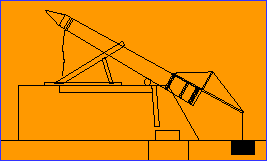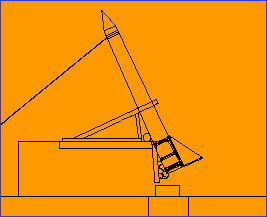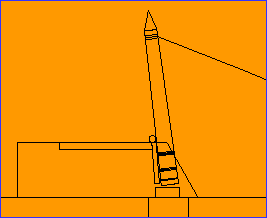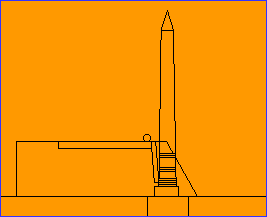
|
 |
 |
Second Chance Part 2 | Back to Part 1 Week 3 (March 20-25): Aswan The real action will take place in this final week. First, using the nine-foot obelisk, Roger Hopkins will demonstrate his theory of erecting an obelisk by lowering it slowly in a chamber from which sand is methodically removed from a trapdoor at the base. (There are vague indications that the Egyptians might have made use of such a method in their day.) Meanwhile, the team will begin preparations for raising the 25-ton obelisk.  Initially, the obelisk will rest on a timber sledge on top of
an earthen ramp. (The ancient Egyptians would have hauled it
up the ramp, but in the interests of time, a crane will place
the NOVA obelisk there.) Notice that the pivot point, shown by
the pivot timber, is about five feet to the right of the
obelisk's center of gravity, which will give its handlers the
greatest control. The obelisk will be securely lashed to the
pivot timber to ensure that it holds to the pivot point.
Attached to the obelisk's butt end will be a wooden cradle,
from which a pair of ropes will descend almost vertically and
will be attached to a granite block set in the ground.
Initially, the obelisk will rest on a timber sledge on top of
an earthen ramp. (The ancient Egyptians would have hauled it
up the ramp, but in the interests of time, a crane will place
the NOVA obelisk there.) Notice that the pivot point, shown by
the pivot timber, is about five feet to the right of the
obelisk's center of gravity, which will give its handlers the
greatest control. The obelisk will be securely lashed to the
pivot timber to ensure that it holds to the pivot point.
Attached to the obelisk's butt end will be a wooden cradle,
from which a pair of ropes will descend almost vertically and
will be attached to a granite block set in the ground. To raise the obelisk, laborers will pull sideways on two other
ropes, which will be attached to the vertical butt-end ropes
about mid-way down. This will give them the greatest
mechanical advantage. (You can test this method yourself by
stretching a rubberband around your thumb and forefinger. Use
your other thumb and forefinger to push out on the inside of
the band. Feel the pressure on the thumb and forefinger
holding the band?) With each tug on the ropes, the obelisk tip
will rise perhaps 5°, and workers will increase the
length of wooden props set between the obelisk and the ramp.
After each pull-and-prop, the vertical butt-end ropes, which
will have become shorter, will be tightened, and the process
will be repeated. The team will use this method to get the
obelisk from 0° to 61°.
To raise the obelisk, laborers will pull sideways on two other
ropes, which will be attached to the vertical butt-end ropes
about mid-way down. This will give them the greatest
mechanical advantage. (You can test this method yourself by
stretching a rubberband around your thumb and forefinger. Use
your other thumb and forefinger to push out on the inside of
the band. Feel the pressure on the thumb and forefinger
holding the band?) With each tug on the ropes, the obelisk tip
will rise perhaps 5°, and workers will increase the
length of wooden props set between the obelisk and the ramp.
After each pull-and-prop, the vertical butt-end ropes, which
will have become shorter, will be tightened, and the process
will be repeated. The team will use this method to get the
obelisk from 0° to 61°. Sixty-one degrees is the critical angle at which the obelisk's
center of gravity will lie directly over the pivot point.
Theoretically, the obelisk could balance perfectly at this
angle. In reality, the workers will have a new concern. Until
this point, the tendency of the obelisk will have been to fall
back down onto the ramp; now it will it be to tip upright. If
the workers lose control of the obelisk at this stage, it
could slam down onto the pedestal, likely missing the "turning
groove" (a slot critical to the raising that one edge of the
base will fit into), perhaps cracking, and possibly
overturning all together.
Sixty-one degrees is the critical angle at which the obelisk's
center of gravity will lie directly over the pivot point.
Theoretically, the obelisk could balance perfectly at this
angle. In reality, the workers will have a new concern. Until
this point, the tendency of the obelisk will have been to fall
back down onto the ramp; now it will it be to tip upright. If
the workers lose control of the obelisk at this stage, it
could slam down onto the pedestal, likely missing the "turning
groove" (a slot critical to the raising that one edge of the
base will fit into), perhaps cracking, and possibly
overturning all together.To ensure that the journey from 61° to the hoped-for 90° happens in a controlled fashion, a pair of ropes that until now have dangled unused from the tip of the obelisk will be pulled taut and held tight by two groups of laborers, who will stand off the front end of the ramp on either side of it. These workers will be responsible for lowering the obelisk into position on its pedestal. No longer needed, the wooden cradle at the butt end will be removed.  As the obelisk tips up, it will come into contact with sand
bags that the team earlier hung over the working end of the
ramp, between it and the bottom half of the obelisk. These
bags will buffer the swing of the obelisk's butt end towards
the ramp. By cutting open the bags one at a time and letting
the sand drain out, the team will help bring the obelisk into
a vertical position in a more controlled manner. If the team
decides the sand buffer is unnecessary, they'll drain the bags
before the obelisk touches them.
As the obelisk tips up, it will come into contact with sand
bags that the team earlier hung over the working end of the
ramp, between it and the bottom half of the obelisk. These
bags will buffer the swing of the obelisk's butt end towards
the ramp. By cutting open the bags one at a time and letting
the sand drain out, the team will help bring the obelisk into
a vertical position in a more controlled manner. If the team
decides the sand buffer is unnecessary, they'll drain the bags
before the obelisk touches them.When the obelisk reaches an angle of 81°, the base of the obelisk will lie more or less directly over the turning groove—though still high above it, held there by the ropes pulling at the tip and by the lashings at the pivot point. Workers will then carefully loosen the pivot-point lashings, allowing the obelisk to slip down into the turning groove.  Once the obelisk has settled into the turning groove, the hard
work will be over. At that point, it will simply be a matter
of pulling the obelisk the final 9° into an upright
position. (Naturally, the team will have to be careful to
ensure the shaft doesn't tip beyond 90°.) If all goes
according to plan, one of the first obelisks raised since
antiquity with (mostly) ancient methods and materials will
stand tall in the Aswan quarry of
Hamada Rashwan.
Once the obelisk has settled into the turning groove, the hard
work will be over. At that point, it will simply be a matter
of pulling the obelisk the final 9° into an upright
position. (Naturally, the team will have to be careful to
ensure the shaft doesn't tip beyond 90°.) If all goes
according to plan, one of the first obelisks raised since
antiquity with (mostly) ancient methods and materials will
stand tall in the Aswan quarry of
Hamada Rashwan.
Explore Ancient Egypt | Raising the Obelisk | Meet the Team Dispatches | Pyramids | E-Mail | Resources Classroom Resources | Site Map | Mysteries of the Nile Home Editor's Picks | Previous Sites | Join Us/E-mail | TV/Web Schedule About NOVA | Teachers | Site Map | Shop | Jobs | Search | To print PBS Online | NOVA Online | WGBH © | Updated November 2000 |